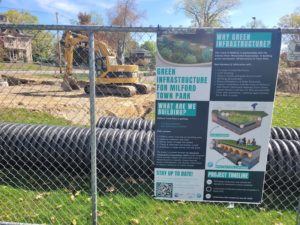Who is a member?
Our members are the local governments of Massachusetts and their elected and appointed leadership.

Green infrastructure projects underway in Milford will feature a rain garden in the Town Park. (Photo courtesy Charles River Watershed Association)
Green stormwater infrastructure projects are underway in Milford and Natick, two towns located along the headwaters of the Charles River, that will help to address river pollution and flooding concerns. The work is being done in collaboration with the Charles River Watershed Association.
Milford worked with the CRWA from 2018 to 2020 to develop a substantial subwatershed restoration plan for the area surrounding Milford Pond. The plan looked for opportunities to naturally filter stormwater runoff to increase ground water levels and treat the stormwater.
The project also identified key areas in the town for protection and conservation that would improve healthy land and river use, and strategies to assist the town with climate change impacts such as flooding and drought. A total of 69 areas were identified to implement green infrastructure projects.
“From that process, the plan we proposed looked at nutrient reduction,” said Robert Kearns, climate resilience specialist at the CRWA, “to support a cleaner Charles River and for the town to comply with the [federal stormwater] MS4 permit.”
The Milford project consists of a system designed to store and filter stormwater, and two rain gardens designed to help filter water, which are nearing completion. The Parks Department will be responsible for the maintenance of the rain gardens, and the Highway Department will maintain the filtering system.
“Essentially it’s going to take the water from the surrounding streets and divert the water into this underground infiltration space that will store it during a flood event but also filter it back into the groundwater,” Kearns said. “Traditionally, with street drainage, it goes directly into the river.”
The rain gardens will reduce the level of phosphorus, a main pollutant found in the Charles River that commonly results from decomposing leaves, fertilizers and detergents. The rain gardens will also help to recharge water back into the ground.
The project is expected to reduce the amount of phosphorus running into the Charles River by 25 pounds annually, Kearns said, and will recharge about .5 acre-feet of rain annually (equivalent to the volume of 55 concrete mixer trucks) into the groundwater.
Milford and the CRWA conducted significant community outreach about the projects in English, Spanish and Portuguese, providing education to students, presentations at town meetings and via Milford TV, and conducting a public survey. Explanatory signs will be located at each system.
The town has received $419,000 for the project from the state’s Municipal Vulnerability Preparedness program. An additional $163,000 is contributed by the CRWA.
“The decisions made on land use upstream are impacting downstream,” Kearns said. “The Charles River flows through many communities, and the pollution makes its way down. … The nutrient pollution from stormwater is what causes a lot of the algae blooms the river experiences.”
The Charles River flows through 23 cities and towns, but its watershed includes 35 communities.
Green stormwater infrastructure projects in Natick — currently in the early design phase — are looking at green streetscape improvements that would allow water runoff to be diverted from streets into filtration systems like those in Milford.
The nearby town of Franklin has also completed green stormwater infrastructure projects such as rain gardens, and has removed pavement from some areas to reduce the amount of impervious surfaces.